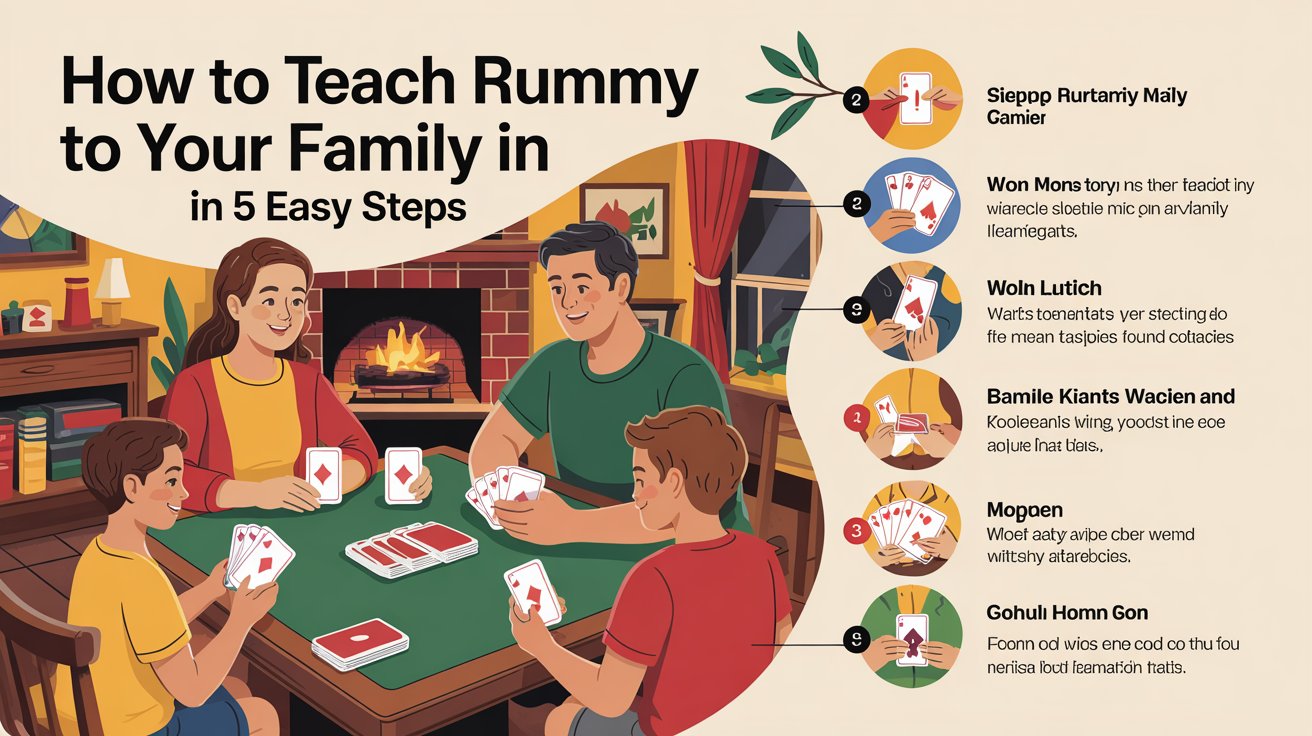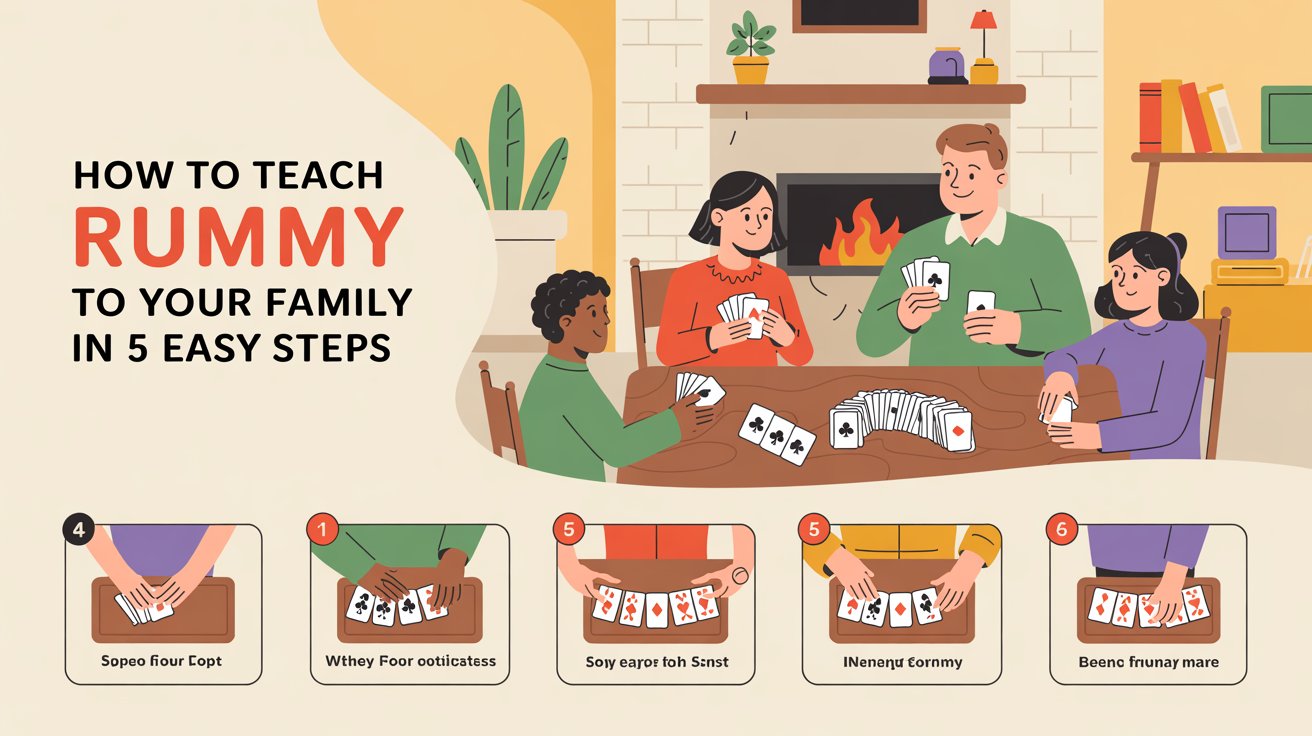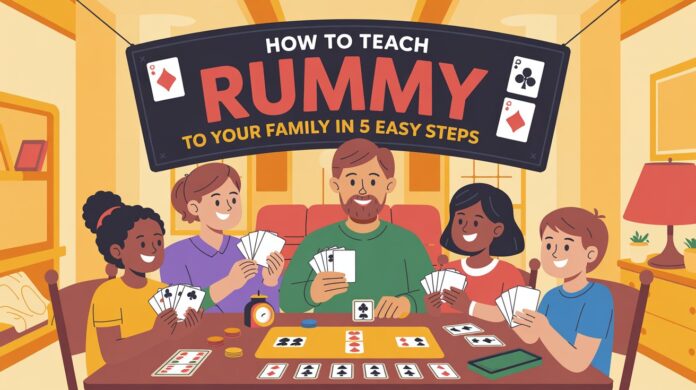Family game nights create lasting memories and strengthen bonds between generations. Among the classic card games that have stood the test of time, Rummy stands out for its perfect balance of strategy, skill, and luck. Whether you’re looking to introduce a new tradition or seeking an engaging activity for your next family gathering, teaching Rummy to your loved ones can provide hours of entertainment and friendly competition.
This comprehensive guide breaks down the process of teaching Rummy into five manageable steps, making it accessible for players of all ages and experience levels. By the end of this article, you’ll have all the tools you need to transform your family into Rummy enthusiasts.
Why Rummy Is Perfect for Family Game Night

Before diving into the teaching process, let’s explore why Rummy deserves a spot in your family game rotation:
- Accessible complexity: Rummy offers enough depth to engage adults while remaining simple enough for children to grasp.
- Balanced gameplay: The mix of strategy and luck means everyone has a chance to win, regardless of age or experience.
- Educational benefits: Players develop pattern recognition, sequencing skills, and strategic thinking.
- Minimal equipment: All you need is a standard deck of cards, making it perfect for travel or impromptu game sessions.
- Scalable player count: Most Rummy variants accommodate 2-6 players, perfect for families of various sizes.
Now, let’s get into the teaching process with our five easy steps.
Step 1: Set the Stage for Success
The foundation of a positive Rummy experience lies in proper preparation. Before shuffling a single card, take time to:
Choose the Right Variant
Rummy has evolved into numerous variations over the centuries. For beginners, start with the most straightforward version:
- Basic Rummy (Straight Rummy): The simplest form, focusing on forming sets and sequences.
- Gin Rummy: A two-player variant that’s quick to play.
- 500 Rummy: Features a scoring system that’s easy to track.
For family settings with mixed ages, Basic Rummy provides the ideal entry point.
Prepare Your Environment
Create a comfortable playing space with these considerations:
- Adequate lighting: Ensure everyone can clearly see their cards.
- Proper seating: A round table works best, but any arrangement where everyone can reach the discard pile will suffice.
- Minimal distractions: Turn off TVs and set phones aside to maintain focus.
- Card holders: For younger children or seniors, plastic card holders can make handling cards easier.
Set a Positive Tone
Approach the teaching session with patience and enthusiasm:
- Emphasize that the first few games are for learning, not winning.
- Establish a no-pressure atmosphere where questions are welcome.
- Consider a practice round where everyone’s cards are face-up while explaining the mechanics.
Step 2: Explain the Basics Clearly
Now that your space is prepared, it’s time to introduce the fundamental concepts of Rummy. Break down the explanation into digestible parts:
Objective of the Game
Start with the ultimate goal:
“In Rummy, we’re trying to form groups of cards and be the first to play all the cards from our hand.”
Explain that there are two types of valid groups:
- Sets (or books): Three or four cards of the same rank but different suits (e.g., three 8s)
- Runs (or sequences): Three or more consecutive cards of the same suit (e.g., 5-6-7 of hearts)
Card Values and Setup
Explain card values and the initial setup:
- Face cards (Jack, Queen, King) = 10 points each
- Aces = 1 point
- Number cards = their face value
- Each player receives 7 cards (adjust to 10 for 2 players)
- The remaining cards form the stock pile
- The top card is turned over to start the discard pile
Basic Turn Structure
Break down the flow of play into simple steps:
- Draw a card: Either take the top card from the stock pile or pick up the top card from the discard pile.
- Form or add to melds: Arrange your hand to form sets and runs.
- Discard one card: Place one card face-up on the discard pile to end your turn.
Use physical demonstrations rather than just verbal explanations. Show examples of valid melds by laying out sample card combinations:
“Here’s a set: three 7s in different suits. And here’s a run: the 4, 5, and 6 of spades in sequence.”
Step 3: Demonstrate With a Practice Hand

Theory becomes much clearer with demonstration. Set up a sample hand visible to everyone and walk through decision-making processes:
Sample Walkthrough
Arrange a hand with these cards: 3♠, 3♥, 3♦, 5♣, 6♣, 7♣, J♠
Explain your thought process: “I notice I have three 3s, which forms a set. I also have 5, 6, and 7 of clubs, which forms a run. The Jack of spades doesn’t fit into any pattern yet, so that would be a good candidate for discarding.”
Highlight Strategy Elements
As you demonstrate, introduce basic strategic concepts:
- Keeping cards that could work in multiple potential melds
- The value of drawing from the discard pile when it helps your hand
- Monitoring which cards other players pick up or discard to guess their strategies
- The importance of discarding high-value cards early to minimize points if someone else goes out
Make this interactive by asking family members what they would do in certain situations: “If I had these cards and saw the 8 of clubs in the discard pile, should I take it? Why?”
Step 4: Play an Open Hand Round
After explanations and demonstrations, the best way to solidify understanding is through an “open hand” practice round:
Setting Up the Open Round
Have everyone lay their cards face-up on the table and play a few rounds with complete visibility. This approach offers several benefits:
- Players can see practical examples of melds forming in real-time
- Family members can help each other identify opportunities
- You can explain strategic decisions as they naturally arise
- Questions can be addressed in context
- Mistakes can be corrected immediately without frustration
Guided Decision Making
During this open round, guide each player through their turns:
- “These three cards could form a run if you draw a 7 of diamonds.”
- “You might want to discard this King since it’s worth 10 points and doesn’t connect to anything else in your hand.”
- “Notice how Mom just picked up that 4 of hearts? That might mean she’s collecting hearts or building a run around 4.”
Introduce Advanced Concepts Gradually
As the open round progresses, you can layer in additional rules and concepts:
- Laying off: Adding cards to melds already on the table
- Going out: The process of playing your last card and ending the round
- Scoring: How points are calculated based on remaining cards
Remember to keep the pace comfortable—introduce new elements only when everyone seems comfortable with the basics.
Step 5: Transition to Regular Play With Support
After one or two open-handed practice rounds, your family should be ready for the real thing—playing with cards concealed. However, the teaching doesn’t stop here:
The First Few Regular Games
During the first few regular games:
- Allow “coaching” for younger players or those who seem hesitant
- Implement a “mercy rule” where players can ask for advice on difficult decisions
- Consider not keeping score for the first game to remove competitive pressure
- Verbalize your own thought process occasionally to model strategic thinking
Create a Reference Sheet
Prepare a simple reference card that players can consult during gameplay:
- Valid meld types with visual examples
- Turn sequence reminder
- Basic strategy tips
- Scoring reminders
This support tool helps new players gain independence while reinforcing what they’ve learned.
Gradual Independence
As games progress, gradually reduce the amount of assistance provided:
- Move from direct advice to asking guiding questions: “What cards might help complete your patterns?”
- Encourage players to explain their strategies after interesting moves
- Introduce friendly challenges like “Can you spot which meld I’m working on based on my discard?”
Celebrate Small Wins
Recognition reinforces learning and keeps the experience positive:
- Acknowledge clever plays regardless of who wins
- Point out when someone successfully implements a strategy you discussed
- Celebrate the first time each player forms a particularly impressive meld
Beyond the Basics: Growing Your Family’s Rummy Skills

Once your family has mastered the fundamentals, you can extend the experience in several ways:
Introduce Variations
After several successful games of Basic Rummy, consider introducing these popular variations:
- Gin Rummy: A faster two-player version with slightly different melding rules
- Oklahoma Gin: A variant where deadwood count can be reduced by laying off cards
- Continental Rummy: Played with two decks and featuring more complex melding requirements
- Canasta: A partnership game played with multiple decks and special rules for wild cards
Host a Family Rummy Tournament
Create excitement with a tournament structure:
- Award simple prizes for various achievements (not just winning)
- Create a family leaderboard to track progress over time
- Establish a regular “Rummy Night” on your family calendar
- Consider themed variations for holidays or special occasions
Connect to Other Card Games
Rummy’s principles create a foundation for learning other classic card games:
- Mahjong: Similar grouping concepts but with tiles instead of cards
- Poker: Different objective but builds on familiarity with card ranks and suits
- Canasta: A natural next step that builds on Rummy principles
- Contract Bridge: Uses different mechanics but builds on card recognition skills
Common Challenges and Solutions
Even with careful teaching, certain challenges might arise. Here’s how to address them:
Problem: Younger Players Getting Frustrated
Solutions:
- Use a smaller hand size (5 cards instead of 7)
- Allow them to see their cards after each round for immediate feedback
- Create “teams” where a younger player partners with an older family member
- Focus on the fun of playing together rather than winning or losing
Problem: Confusion About Valid Melds
Solutions:
- Create a visual reference chart showing examples of valid and invalid combinations
- Use colored card holders to visually separate potential melds
- Practice sorting exercises between games to develop pattern recognition
- Allow “checking” of potential melds before playing them
Problem: Slow Play Disrupting Game Flow
Solutions:
- Use a gentle timer for turns (1-2 minutes)
- Practice card organization techniques (grouping by suit or rank)
- Encourage preparation during other players’ turns
- Focus on the social aspect rather than perfect strategy
Conclusion
Teaching Rummy to your family creates more than just an entertaining pastime—it establishes a tradition of togetherness that can span years. Through these five steps, you’ve provided your loved ones with a skill that offers cognitive benefits, social connection, and simple joy.
Remember that the ultimate goal isn’t creating card sharks but fostering moments of family bonding. Approach the teaching process with patience, keep the atmosphere light, and celebrate the journey of learning together.
Before long, you might find your family requesting “just one more game” before bedtime—the true mark of Rummy teaching success!
So shuffle the deck, deal the cards, and watch as your family discovers the timeless pleasure of this classic card game. The memories you create around the table will last far longer than any winning streak.
Ready to deal the first hand? Your family’s Rummy adventure awaits!

Zareb Saleh is a journalist at Gulf Today and a ghostwriter for Gameoholic, specializing in gaming, technology, and digital culture. With a keen eye for industry trends, he delivers insightful stories that engage and inform readers.




